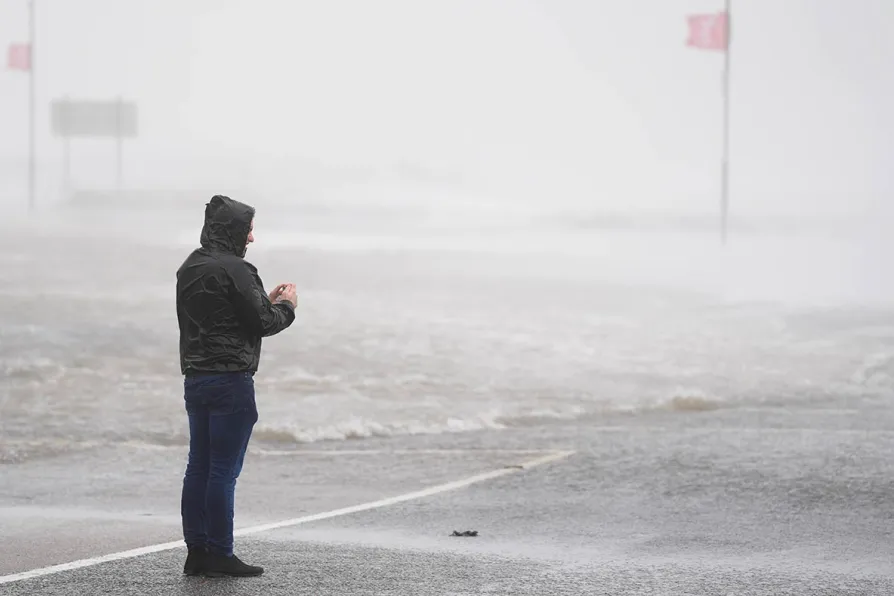RUBEN BRETT of Liberation explains why the narratives we hear about the poverty-stricken Caribbean nation are deeply misleading
High pressures squeeze and crush, but low pressures damage too. Losing the atom-level buzz that keeps us held safe in the balance of internal and external pressure releases dangerous storms, disorientation and pain, write ROX MIDDLETON, LIAM SHAW and MIRIAM GAUNTLETT

 A person wheeling his bike on the promenade in Salthill, Galway as Strom Amy batters Ireland, October 3, 2025
A person wheeling his bike on the promenade in Salthill, Galway as Strom Amy batters Ireland, October 3, 2025
STORM AMY battered Ireland and Britain — especially Scotland — this weekend, felling trees and powerlines, causing floods, destroying structures and leaving 33,000 people without electricity.
This was the first named storm of this year’s season, which runs from September 1. It was historic in breaking the record for low pressure recorded in Britain in October, with a reading of 94.7 kilopascals in the Shetland isles. The kilopascal (kPa) is a standard unit of pressure: the usual reading for atmospheric pressure at sea level is just above 100 kPa.
Low pressure at sea level is correlated with high winds and storm intensity. It’s not quite right to say that low pressure causes winds. Pressure is, simply put, the bumping of air particles into each other.
So, a region of low pressure is a reduction in the number of air particles in a given volume, compared to the air around it.
This reduction means that other particles move into the space — creating a wind — but the wind itself also causes low pressure, because air particles moving out of one space reduces the number left behind.
It’s a feedback loop that intensifies storms from lighter winds and patches of low air pressure. The winds swirl round and round the eye of the storm — the area of lowest air pressure — just as the feedback loop swirls around itself.
Though storms are a headache for everyone once they arrive, for some people, they are a headache even beforehand. We all have the ability to sense high and low atmospheric pressures.
But for some people, changes in pressure can produce headaches or migraines. Thought to be due to sensitivity in the sinuses and blood vessels of the brain, some people can experience severe pain when pressure changes because of the weather.
These changes are a small fraction of the total pressure we experience. The pressure of the air above us at sea level is around 100 kPa; to experience another 100 kPa of extra pressure, you need to go 10 metres underwater.
Our bodies have an internal pressure that is equal to the external pressure, and this balance of internal and external pressures keeps us healthy.
Air pressure at sea level is actually very stable. Even in violent storms and strange weather events, the all-time minimum and maximum pressures recorded at sea level are 87kPa and 109kPa, respectively.
An easy way to experience changes in pressure is through changes in altitude. The Earth’s atmosphere exists because gravity holds air close to the Earth.
The force of gravity decreases the further from the Earth’s surface you are, and so the pressure in the atmosphere reduces quickly with each kilometre you travel upwards from sea level.
Planes, which typically travel above 30,000 feet, are pressurised to make sure that the people in the cabin don’t get ill. But they are only pressurised to the equivalent altitude of 8,000 feet (2.4km), which is 80kPa, much lower than the pressure experienced in lows of storms at sea level.
The reason why passengers are kept in relatively low pressure while in the air is to reduce the strength of the plane body required. Withstanding pressure is all about balance, the difference between the pressure inside the container to the pressure outside the container.
A simple demonstration of this is filling an empty drinks can with steam, flushing out all the air to reduce the pressure inside it, then turning it upside down onto water. The lack of pressure inside the can means that normal atmospheric pressure can crush the thin aluminium of the can completely.
The same forces are at play in a plane. The minimum possible air pressure is maintained inside the cabin, otherwise the plane would need to be sturdier and heavier in order to withstand the difference between inside and outside.
At quarter to 11 on Friday July 13 2018, a Ryanair flight from Dublin to Zadar in Croatia lost pressure in the cabin while travelling at 36,000 feet over France. At this altitude, you have about 15-20 seconds of “useful consciousness” before the lack of oxygen takes effect.
As passengers scrambled to put on the oxygen masks that had dropped from the ceiling, the pilot dove the plane down in the sky to 9,000 feet in just five minutes. At this altitude, there is enough oxygen to survive, and the air pressure is high enough that the cabin doesn’t need artificial pressure. They eventually landed in Frankfurt.
All 189 people on board survived, although 33 were treated for the physical effects of depressurisation — mostly bleeding from the ears, and the trauma of the event left passengers reeling.
Ryanair started paying out compensation in 2022. Though Ryanair shouldn’t have flown people in a dangerous plane, the piloting that saved these people was a remarkable feat.
Storm Amy was particularly dramatic. It’s predicted that Britain will suffer similar, more intense storms as the effects of climate change become more pronounced.
That’s concerning because of the dire state of Britain’s storm readiness. Both government and independent panels persistently release reports indicating that this is a major issue. For example, the Climate Change Committee’s 2025 report states that “Britain’s preparations for climate change are inadequate.”
The report goes on to detail how farmland, motorways and trainlines are at risk of flooding and landslides, clean drinking water is at risk of pollution from waste overflows and drought, telephone and electricity lines are threatened, and homes, people and businesses are under pressure from flooding and coastal erosion.
The Institute of Civil Engineers has also called for more action from the government. After a year in office, the government has introduced policy on clean energy, but it says it has not started to enact real change or address “glaring gaps.” Money has been pledged for flood defences, but as the institute says, climate change is not just about floods.
The parliamentary joint committee on the national security strategy described huge problems in critical infrastructure. Across the world, it is likely that the same problems are awaiting many people as climate change intensifies.
Climate change is another circular process. As with storms, it is likely that feedback loops can and will create even worse problems.
The critical reports highlight that the same is true of infrastructure, with the combined interdependency of data, power and communication networks meaning that breaches in infrastructure because of storms become increasingly difficult to fix.










